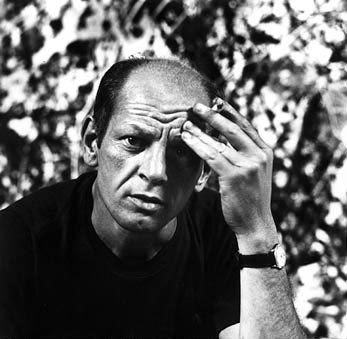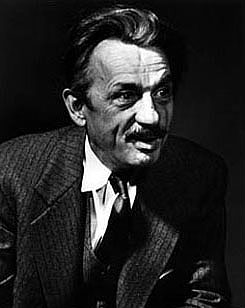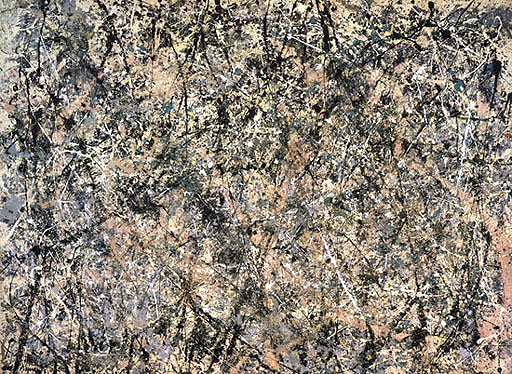Samantha Gardner - Jackson Pollock, A Visionary

Picture from National Gallery of Arts Website
"When I
am in my painting, I’m not aware of what I’m doing. It is only after a sort
of ‘get acquainted’ period that I see what I have been about.
I have no fears about making changes, destroying the image, etc., because
the painting has a life of its won. I try to let it come through.
It is only when I lose contact with the painting that the result is a mess.
Otherwise there is pure harmony, an easy give and take, and the painting comes
out well."
- Jackson Pollock 1912-1956
|
Jackson Pollock was a pioneer of abstract expressionism. He was born in 1912 in Cody, Wyoming and died in 1956 from an abrupt car accident near East Hampton, New York. He began to study painting in 1929 under the supervision of the regionalist painter Thomas Hart Benton. When he first began painting he was strongly influence by the Regionalist painters. He was also influenced in some ways by the Mexican muralists and the surrealists. (WebMuseum) He started to develop his own style by the 1940’s; painting in a completely abstract manner. In 1945 he married Lee Krasner, who was another abstract expressionist but she did not gain respect for her artwork until after Pollock’s death. The abstract expressionists used many different media and worked in a variety of styles. They shared a commitment to large scale, abstract works, an interest in Jungian psychological theories to collective unconscious and primitive mythology, and a belief that expressiveness was achieved, in part, through the physical process of painting. They projected philosophy, art history, and human experience into a visual form. Incorporating chance and control while painting with a physical immediacy and gesture. Two divergent stylistic tendencies emerged within this movement in the early 1950’s. One of the styles can be seen in the works of Mark Rothko and Barnett Newman who emphasized the use of chromatic abstraction. The other can be seen in the works of Pollock and Willem de Kooning who worked with gestural abstraction. Pollock used the method of dripping and splashing, he fixed the canvas to the floor then pouring and dripping the paint from the can onto the canvas. When the paint was on the canvas he would manipulate it with sticks, trowels, or knives, whatever tool he wanted to use at the time. In 1947 he stated: "On the floor I am more at ease, I feel nearer, more a part of the painting, since this way I can walk around it, work from the fours sides and be literally ‘in’ the painting." -Jackson Pollock (WebMuseum)
|
In 1934 Pollock’s painting of a frontier journey connected his teachers, Benton, style with his own American West roots and from this Benton established that Pollock had found "the essential rhythms" of art. (www.nga.gov.) His first professional work, titled Flame, showed a radical shift in his artistic direction and is a clear step towards abstraction. It was his first attempt to free expression from the subject. After his marriage in 1945, he moved to Long Island and it was from his walks in the meadows and the woods near his home that he gained inspiration for his most famous works. The Mexican muralists believed in the primal continuum between ancient and contemporary cultures and this helped Pollock’s passion for Native American art. Pollock suffered a breakdown at the age of 26 because of creative blocks and his desire for alcohol. It was then that Pollock sought the help of a Jungian psychoanalyst who made him aware that emotions had become the central challenge in his life and his work. It was Pollock’s internal turmoil that drove him to paint. The work that I have seen that most inspires me is titled Lavender Mist and it shows his ultimate style with physical action and emotional expression achieving a balance. He poured, dripped and flung the paint onto the canvas in a sense of movement and emotion. Each person feels differently when they look at it, I feel alive almost like I am watching the world move at light speed. Jackson Pollock’s work is inspiring to many people and it has helped many people learn to express themselves. |
|
|
|
References:
Pollock, Jackson. Retrieved November 19, 2004 from http://www.ibiblio.org/wm/paint/auth/pollock/
Jackson Pollock. Retrieved November 19, 2004 from http://www.nga.gov/feature/pollock/pollockhome.html.
Jackson Pollock 1912-1956. Retrieved November 19, 2004 from http://www.beatmuseum.org/pollock/jacksonpollock.html.


